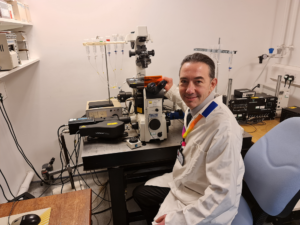
Physiology News Magazine
Lab spotlight
Studying pain perception
Membership
Lab spotlight
Studying pain perception
Membership

https://doi.org/10.36866/pn.126.41
Professor Nikita Gamper
University of Leeds, UK
Nikita presenting at the Processing and Modulation of Sensory Signals: From the Periphery to the Cortex conference on 20 – 21 June discuss their lab’s sensory physiology research.
I am a neuroscientist and biophysicist with interests in neuronal communication, intracellular signalling and mechanisms of pain transmission. I graduated in Biology/Biochemistry from the St Petersburg State University, Russia in 1995. In 1999 I obtained a PhD in Physiology from the Sechenov Institute of Evolutionary Physiology and Biochemistry (Russian Academy of Science) St Petersburg, Russia.
After six years of postdoctoral study at Tubingen University, Germany and at the University of Texas Health Science Center at San Antonio, US, I joined the Faculty of Biological Sciences at the University of Leeds in 2006, where I am currently appointed as a Professor of Neuroscience. Since 2011, I have carried out research at the Department of Pharmacology at Hebei Medical University in Shijiazhuang, China as an adjunct professor of pharmacology.
Our research, both in Leeds and in Shijiazhuang, is focused on cellular, molecular and biophysical principles of neuronal communication, especially in relation to somatosensory physiology and pain processing. One of our main focuses is on our recent discovery of GABAnergic modulation of throughput spike conduction in the spinal somatosensory ganglia. These findings are highly discussed in the field and could amount to a novel principle of somatosensory processing in mammals.

We also have a long track record in studying ionic mechanisms of nociception and pain. Our group have contributed to elucidation of the role and modulation of TMEM16A (ANO1), M-type K+ channels and T-type Ca2+ channels in the peripheral pain pathways. Several current projects are focused on the modulation of these channels in sensory neurons by G protein-coupled receptors (GPCRs). Specifically, we are looking at the molecular organisation of localised GPCR signalling in sensory neurons in relation to inflammatory pain.
We also reported on transcriptional and epigenetic regulation of sensory neuronal gene expression associated with chronic pain. One specific focus of this line of enquiry is on transcriptional repressor REST (neuronrestrictive silencer factor (NRSF)) and its role in neuropathic remodelling of peripheral
nerves in chronic pain states.
Our group is keen on the development of new methods and approaches for molecular neuroscience research. We recently developed, and modified for use with sensory neurons, single molecule localisation methods (STORM, DNAPAINT, proximity ligation), an all-optical method for simultaneous measurement of intracellular Ca2+ dynamics and chloride channel activity.
We are also developing neurophysiological approaches for simultaneous in vivo recordings from multiple sites along the somatosensory circuits. Lately, we adopted tissue clearing and light sheet imaging of whole spinal somatosensory ganglia for accurate morphometry, as well as developing multiple computational approaches to evaluate neuronal activity.

